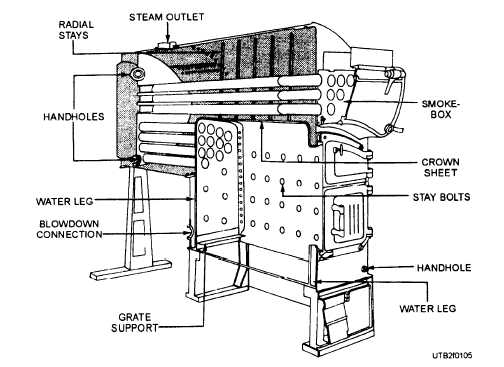The initial cost of the HRT boiler is relatively low
and installing it is not too difficult. The boiler setting can be readily changed to meet different fuel requirements - coal, oil, wood, or gas. Tube replacement is also a comparatively easy task since all tubes in the HRT boiler are the same in size, length, and diameter.
The gas flows in the HRT boiler from the firebox to the rear of the boiler. It then returns through the tubes to the front where it is discharged to the breaching and out the stack.
The HRT boiler has a pitch of 1 to 2 inches to the rear to allow sediment to settle toward the rear near the bottom blowdown connection. The fusible plug is located 2 inches above the top row of tubes. Boilers over 40 inches in diameter require a manhole in the upperpart of the shell. Those over 48 inches in diameter must have a manhole in the lower, as well as in the upper, part of the shell. Do not fail to familiarize yourself with the location of these and other essential parts of the HRT boiler. The knowledge you acquire will definitely help in the performance of your duties with boilers.
Firebox Boiler
Another type of fire-tube boiler is the FIREBOX boiler that is usually used for stationary purposes. A split section of a small firebox boiler is shown in figure 1-5.
Gases in the firebox boiler make two passes through the tubes. Firebox boilers require no setting except possibly an ash pit for coal fuel. As a result, they can be quickly installed and placed in service. Gases travel from the firebox through a group of tubes to a reversing chamber. They return through a second set of tubes to the flue connection on the front of the boiler and are then discharged up the stack.
Q6. What are the two types of boilers?
Q7. What are the four types office-tube boilers?
Q8. What is the primary factor that allows the firebox boiler to be quickly installed and placed into service?
BOILER FITTINGS AND ACCESSORIES
Learning Objective: Describe the function and operation of the different types of boiler fittings and accessories.
Now that the basic structure of a boiler has been explained, boiler fittings (fig. 1-6) and the operation or function of various devices, such as controls, valves, and try cocks, must be presented. A sufficient number of essential boiler fittings and accessories are discussed in this section to provide a background for further study. As a reminder, and in case you should run across some unit

Figure 1-5. - Split section of a small firebox boiler.
Continue Reading